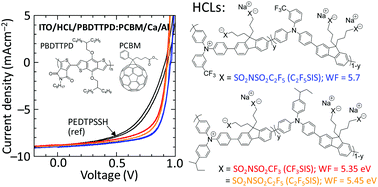|
Bulk ion-clustering and surface ion-layering effects on work function of self-compensated charged-doped polymer semiconductors
12/12/2019. Building on previous work on solution-processable, workfunction-tuneable, self-compensated charge-doped injection/collection layers, a team from ONDL and their partners in NUS Physics have discovered that larger tethered anions exhibit stronger surface ionic layering. This contributes to increasing both the HOMO ionization energy of the undoped polymer, and the vacuum work function (WF) of the hole-doped polymer, which provides the desired ‘fine tuning’ of these parameters. From molecular dynamics simulations of the ion cluster structure in the bulk, it was also observed that the larger anions produce a larger average distance to the holes, additionally increasing their inherent WF. Larger anions also impart better solubility in polar solvents used in device fabrication. Combined, these effects allow the self-compensated layers to be advantageous in their applications in semiconductor devices. Finally, high performance organic solar cells and diodes were demonstrated with such materials. DOI: 10.1039/c9mh01749f
 Graphical abstract: (Left) High performance self-compensated hole collection layers (HCLs) used in place of the common HCL PEDT:PSSH demonstrate superior performance as seen in the J-V plot of an organic solar cell. Curve colours corresponds to the polymer semiconductors seen on (Right). Graphical abstract: (Left) High performance self-compensated hole collection layers (HCLs) used in place of the common HCL PEDT:PSSH demonstrate superior performance as seen in the J-V plot of an organic solar cell. Curve colours corresponds to the polymer semiconductors seen on (Right).
|

